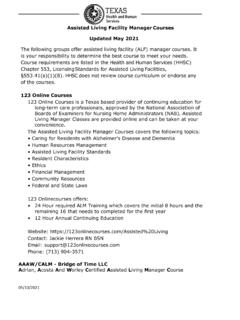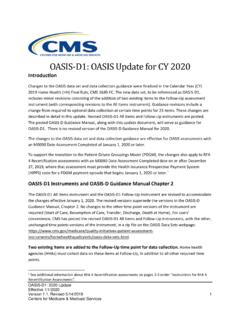Transcription of This is an archive page that is no longer being updated ...
1 17 Figure 5. The vertical dipole and itselectromagnetic equivalent, the verticalmonopole5. ANTENNA TYPESA ntennas can be classified in several way is the frequency band of include physical structure andelectrical/electromagnetic design. Theantennas commonly used for LMR both atbase stations and mobile units representonly a very small portion of all the simple, nondirectional antennas arebasic dipoles or monopoles. More complex,directional antennas consist of arrays ofelements, such as dipoles, or use one activeand several passive elements, as in the antenna technologies are beingdeveloped that allow an antenna to rapidlychange its pattern in response to changes indirection of arrival of the received antennas and the supportingtechnology are called adaptive or smart antennas and may be used for the higher-frequency LMR bands in the and MonopolesThe vertical dipole or its electromagneticequivalent, the monopole could beconsidered one of the best antennas for LMRapplications.
2 It is omnidirectional (inazimuth) and, if it is a half-wavelength long,has a gain of (or G = dBi) in thehorizontal plane. A center-fed, verticaldipole is illustrated in figure 5(a). Althoughthis is a simple antenna, it can be difficult tomount on a mast or vehicle. The idealvertical monopole is illustrated infigure 5(b). It is half a dipole placed in half-space, with a perfectly conducting, infinitesurface at the monopole over an infinite ground plane istheoretically the same (identical gain,pattern, etc., in the half-space above theground plane) as the dipole in free space. Inpractice, a ground plane cannot be infinite,but a ground plane with a radiusapproximately the same as the length of theactive element, is an effective, practicalsolution.
3 The flat surface of a vehicle s trunkor roof can act as an adequate ground 6 shows typical monopole antennasfor base-station and mobile applications. Archival Notice This is an archive page that is no longer being updated . It may contain outdated information and links may no longer function as originally intended. Archival Notice This is an archive page that is no longer being updated . It may contain outdated information and links may no longer function as originally intended. Archival Notice This is an archive page that is no longer being updated . It may contain outdated information and links may no longer function as originally intended. Archival Notice This is an archive page that is no longer being updated . It may contain outdated information and links may no longer function as originally intended.
4 18 Figure 6. Typical monopole antennas for(a) base-station applications and (b) mobileapplicationsFigure 7. Omnidirectional base-stationantennasFigure 8. A monopole antenna horizontal-plane pattern, base-station application. Theuniform maximum gain corresponds to theouter line on the polar ApplicationsFor base-station installations (where anomnidirectional pattern is desired), there aretwo practical implementations of the verticaldipole. The first type is the sleeve antenna,as illustrated in figure 7(a). The sleeveantenna is a vertical dipole with the feed(transmission line) entering from one end ofa hollow element. The second type is amonopole over a ground plane, as illustratedin figure 7(b). The monopole in this illustra-tion uses a set of four wire elements toprovide the ground plane.
5 Figure 8 shows atypical pattern for a base-station variation of the dipole antenna is thefolded dipole as shown in figure 9. Itsradiation pattern is very similar to the simpledipole, but its impedance is higher and it hasa wider 10. Typical mobile ApplicationsNearly all vehicular antennas are monopolesmounted over a (relatively) flat body surface(as described above). In this application, themonopole is often called a whip VHF low-band, a quarter-wave monopolecan be m (approximately 8 ft) , an inductor (coil) at the base of amonopole adds electrical length, so thephysical length of the antenna can beshorter. Although this kind of loaded antenna will appear to be a quarter-waveantenna, it will have a gain value somewhatless than a true quarter-wave monopole.
6 Thisdisadvantage can be somewhat offset,however, by the ability to mount the(shorter) antenna in the center of a surfacethat will act as an acceptable ground plane( , the roof or trunk of the vehicle).Figure 10(a) shows an illustration of thiskind of of the vehicular antennas at VHFhigh-band are quarter-wave monopoles. At150 MHz, this would mean that a whipantenna, approximately m ( ft) long,is needed. Half-wave and 5/8 wavemonopoles also are used, but they requiresome sort of matching network ( ,inductors and/or capacitors) in order tomatch the antenna impedance to that of thetransmission line. These longer antennashave a gain of approximately 3 UHF, a quarter-wave whip isapproximately 15 cm (6 in) long. Since thislength is physically small, some designconsiderations can be used to increase thegain.
7 For example, as shown in figure 10(b),two 5/8 wave monopoles can be stacked with a phasing coil between them. This is,effectively, an antenna array (see sec. )that provides a gain of approximately 5 800 MHz, a quarter-wave monopole doesnot perform well, so the approach ofstacking two monopoles, with a phasing coilbetween, is used. Such an antenna,illustrated in figure 10(c), looks much like amobile cellular phone antenna and has a gainof approximately 3 azimuthal pattern of all monopoles isideally a circle. In other words, the gainversus azimuth angle in the horizontal planeis constant. In practice, the pattern in thehorizontal plane generally is notomnidirectional, since the portion of thevehicle used as a ground plane is notsymmetric, and usually there are otherobstructions.
8 Figure 11 shows the horizontalplane pattern for an 840 MHz whip locatedin the center of the roof of a vehicle [13].The dotted line in the figure shows theeffects, on the pattern, of a law-enforcementFigure 9. A folded-dipole antenna20 Figure 11. A mobile antenna horizontal-plane pattern [13]Figure 12. Corner-reflector antennaslight bar mounted on the roof ahead of ReflectorAn antenna comprised of one or more dipoleelements in front of a corner reflector, calledthe corner-reflector antenna, is illustrated infigure 12. A photograph of a typical cornerreflector is shown in figure antenna has moderately high gain, butits most important pattern feature is that theforward (main beam) gain is much higherthan the gain in the opposite direction.
9 Thisis called the front-to-back ratio and isevident in the pattern shown in figure antenna design that uses passiveelements is the Yagi antenna. This antenna,illustrated in figure 15, is inexpensive andeffective. It can be constructed with one orFigure 13. A typical corner-reflectorantennaFigure 14. A corner-reflector antennahorizontal-plane pattern21 Figure 15. The Yagi antenna (a) three elements and (b) multipleelementsmore (usually one or two) reflector elementsand one or more (usually two or more)director elements. Figure 16 shows a Yagiantenna with one reflector, a folded-dipoleactive element, and seven directors, mountedfor horizontal 17 is a typical pattern for a three-element (one reflector, one active element,and one director) Yagi antenna.
10 Generally,the more elements a Yagi has, the higher thegain, and the narrower the beamwidth. Thisantenna can be mounted to support eitherhorizontal or vertical polarization and isoften used for point-to-point applications, asbetween a base station and somewhat novel, but very useful, design isthe log-periodic antenna. This antenna isbased on the dipole element. As shown inthe illustration of figure 18, it is in factcomprised of a set of dipoles, all active, thatvary in size from smallest at the front tolargest at the rear. Usually, this antenna isconstructed so the antenna terminals arelocated at the front (on the shortest dipole).Figure 19 shows a typical installation. Thekey features of this antenna are, first of all,its broadband nature, and second, itsrelatively high front-to-back gain ratio.















